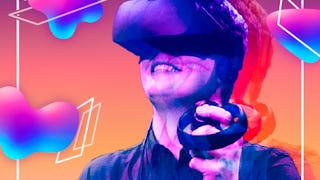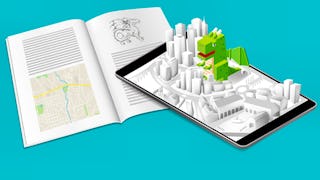Dieser dritte Kurs der Spezialisierung XR für Jedermann ist auf die technische Entwicklung von XR-Erlebnissen ausgerichtet. Der Kurs vermittelt den Lernenden ein eher technisches Denkmodell der XR-Technologien und die Werkzeuge, um die XR-Entwicklung mit Zuversicht anzugehen. Er führt durch die Entwicklungsphasen für VR- und AR-Projekte und stellt die wichtigsten XR-Entwicklungsplattformen sowie die wichtigsten Methoden und Werkzeuge vor. Dieser dritte Kurs hilft den Lernenden auch dabei, fortgeschrittene XR-Anforderungen aus physischen/digitalen Prototypen abzuleiten, und lehrt sie, wie sie die wichtigsten technischen Probleme unterscheiden, die Entwicklungskosten abschätzen und die für die Weiterentwicklung von XR notwendige Forschung planen können. Dieser Kurs hat auch einen Honors Track, der die Lernenden bei der Implementierung von 3D-, VR- und AR-Szenen in WebXR mit A-Frame und in Unity anleitet und ihnen hilft, einen Entwicklungsplan mit klaren Meilensteinen und Ergebnissen zu erstellen.

Genießen Sie unbegrenztes Wachstum mit einem Jahr Coursera Plus für 199 $ (regulär 399 $). Jetzt sparen.

Entwicklung von AR/VR/MR/XR-Anwendungen mit WebXR, Unity & Unreal
Dieser Kurs ist Teil von Spezialisierung für Erweiterte Realität für alle
Unterrichtet in Deutsch (KI-Synchronisation)

Dozent: Michael Nebeling
13.371 bereits angemeldet
Bei enthalten
(94 Bewertungen)
Was Sie lernen werden
Erstellen Sie einfache und immersive VR-Szenen in WebXR oder Unity.
Erstellen Sie markerbasierte und markerlose AR-Szenen in WebXR oder Unity.
Verstehen Sie grundlegende Konzepte und Techniken für fortgeschrittene XR-Anwendungen.
Entwickeln Sie XR-Anwendungen unter Berücksichtigung von Ethik, Zugänglichkeit und Datenschutz.
Kompetenzen, die Sie erwerben
- Kategorie: Web-Entwicklungstools
- Kategorie: Anwendungsentwicklung
- Kategorie: Einheit-Engine
- Kategorie: Erweiterte und virtuelle Realität (AR/VR)
- Kategorie: Benutzeroberfläche (UI)
- Kategorie: 3D-Assets
- Kategorie: User Experience Design
- Kategorie: Unreal Engine
- Kategorie: Erweiterte Realität
- Kategorie: Prototyping
- Kategorie: Plattformübergreifende Entwicklung
- Kategorie: Virtuelle Realität
- Kategorie: Interaktionsdesign
- Kategorie: Mensch-Computer-Interaktion
Wichtige Details

Zu Ihrem LinkedIn-Profil hinzufügen
Erfahren Sie, wie Mitarbeiter führender Unternehmen gefragte Kompetenzen erwerben.

Erweitern Sie Ihre Fachkenntnisse
- Lernen Sie neue Konzepte von Branchenexperten
- Gewinnen Sie ein Grundverständnis bestimmter Themen oder Tools
- Erwerben Sie berufsrelevante Kompetenzen durch praktische Projekte
- Erwerben Sie ein Berufszertifikat zur Vorlage

In diesem Kurs gibt es 4 Module
Dieses erste Modul behandelt drei Hauptansätze für die XR-Entwicklung: WebXR, Unity und Unreal. Jeder Ansatz erfordert unterschiedliche Entwicklungstools, Programmiersprachen und technische Fähigkeiten. Sie unterscheiden sich auch in der Wiedergabetreue und Qualität, die erreicht werden kann, und darin, wie viele Geräte und Benutzer damit erreicht werden können. Neben einem grundlegenden Überblick über die XR-Entwicklungsplattformen und -tools geht es in dieser Woche vor allem darum, den Sprung von 2D zu 3D zu schaffen: Viele unserer Kursteilnehmer werden mit der Web- und Mobilentwicklung vertraut sein, aber die 3D-Entwicklung ist ganz anders. Im Kurs "Honors" werde ich Sie durch die Erstellung Ihrer ersten 3D-Szene mit WebXR, Unity oder Unreal führen. Ich werde Ihnen auch Anleitungen für die ersten Schritte in jedem dieser Programme geben, so dass Sie analysieren und vergleichen können, bevor Sie Ihren Ansatz und Ihre Tools auswählen.
Das ist alles enthalten
14 Videos17 Lektüren1 Aufgabe2 App-Elemente4 Diskussionsthemen
Dieses zweite Modul konzentriert sich auf die Entwicklung von VR-Anwendungen. Wir werden lernen, was es braucht, um eine virtuelle Realität zu erstellen, über Menüs und Navigationstechniken in VR sowie über die Auswahl und Manipulation von Objekten. Ich werde verschiedene Beispiele vorstellen, die ich mit WebXR implementiert habe, um die Konzepte zu veranschaulichen. Ich werde auch auf Ansätze in Unity und Unreal eingehen. Sie werden auch sehen, wie ich Demos direkt in VR zeige, um besser zu verstehen, wie Navigation und Interaktion in VR funktionieren. Viele der Lektionen basieren auf einer VR-Design-Fallstudie, die durch den Detroit Zoo inspiriert wurde und die meine Studentin Kara Dailey und ich speziell für diesen XR MOOC erstellt haben. Im Kurs "Honors" werde ich Sie durch die Erstellung Ihrer ersten VR-Szene mit A-Frame, Unity oder Unreal führen. Außerdem biete ich weitere praktische Vorlesungen an, in denen ich Ihnen zeige, wie Sie mit WebXR und A-Frame grundlegende und immersive VR-Szenen erstellen.
Das ist alles enthalten
12 Videos2 Lektüren1 Aufgabe2 App-Elemente
Dieses dritte Modul konzentriert sich auf die Entwicklung von AR-Anwendungen. Wir werden uns mit markerbasierten und markerlosen Ansätzen zur Erweiterung der Umgebung, mit dem Design und der Rolle von Markern für das Prototyping und den Einsatz sowie mit den Unterschieden zu markerloser AR beschäftigen. Auch hier werde ich verschiedene Beispiele vorstellen, die ich mit WebXR implementiert habe, um die Konzepte zu veranschaulichen. Ich werde auch auf Ansätze in Unity und Unreal eingehen. Wir werden auch die Unterschiede im Design zwischen handgehaltener und am Kopf getragener AR kennenlernen. Viele der Lektionen basieren auf einer AR-Design-Fallstudie zu Keplers Gesetzen der Planetenbewegung, die meine Studentin Shwetha Rajaram und ich in einem unabhängigen Studienprojekt erstellt haben. Im Honors Track werde ich Sie durch die Erstellung Ihrer ersten AR-Szene mit A-Frame, Unity oder Unreal führen. Außerdem werde ich Ihnen in praktischen Vorträgen zeigen, wie Sie markerbasierte und markerlose AR-Szenen mit WebXR unter Verwendung von A-Frame erstellen können.
Das ist alles enthalten
13 Videos2 Lektüren1 Aufgabe2 App-Elemente
Dieses vierte und letzte Modul wird den Umfang dieses Kurses erweitern, indem es Sie in fortgeschrittene Techniken und auch in die Forschung im Bereich XR einführt. Was die fortgeschrittenen Techniken betrifft, so werden wir etwas über prozedurale Generierung, umgelenktes Gehen und angepasste Controller für VR lernen. Ich werde auch 3D-Rekonstruktion, Objekterkennung und angepasste Displays für AR behandeln. Ich werde Beispiele aus der jüngsten Forschung anführen. Wir werden auch wichtige Themen wie Barrierefreiheit, Zusammenarbeit und Personalisierung von XR-Erlebnissen besprechen. Diese Themen finden in der aktuellen Forschung zunehmend Beachtung und werden die XR-Landschaft in den nächsten fünf bis zehn Jahren maßgeblich prägen. Ich werde auch einen Vortrag über XR-Forschung halten, in dem ich eines unserer jüngsten Forschungsprojekte vorstelle und die vielen Iterationen präsentiere, die es auf der Grundlage von Nutzer- und Systemleistungsbewertungen durchlaufen hat. Ich werde auch über gute und schlechte Forschungsfragen sprechen, was vor allem mit dem Umfang und der Frage zu tun hat, wie weit man gehen möchte. Schließlich werde ich meinen Making of the XR MOOC vorstellen, in dem ich einige der Techniken erläutern möchte, die ich bei der Durchführung, Aufzeichnung und Weitergabe von Demos mit AR/VR-Technologien eingesetzt habe. Im Honors Track werden wir unsere Projekte mit einer Peer Review von 3D-, VR- oder AR-Szenen abschließen.
Das ist alles enthalten
9 Videos4 Lektüren1 Aufgabe1 peer review1 Diskussionsthema1 Plug-in
Erwerben Sie ein Karrierezertifikat.
Fügen Sie dieses Zeugnis Ihrem LinkedIn-Profil, Lebenslauf oder CV hinzu. Teilen Sie sie in Social Media und in Ihrer Leistungsbeurteilung.
Dozent

Mehr von Design und Produkt entdecken
 Status: Kostenloser Testzeitraum
Status: Kostenloser TestzeitraumUniversity of Michigan
 Status: Kostenloser Testzeitraum
Status: Kostenloser TestzeitraumUniversity of Michigan
 Status: Vorschau
Status: VorschauInstitut Mines-Télécom
 Status: Kostenloser Testzeitraum
Status: Kostenloser TestzeitraumUniversity of Michigan
Warum entscheiden sich Menschen für Coursera für ihre Karriere?




Bewertungen von Lernenden
94 Bewertungen
- 5 stars
81,91 %
- 4 stars
8,51 %
- 3 stars
3,19 %
- 2 stars
1,06 %
- 1 star
5,31 %
Zeigt 3 von 94 an
Geprüft am 5. Aug. 2024
that was awesome, thanks for creating such a nice course
Geprüft am 13. Aug. 2023
Very good learning experience, highly recommended for anyone interested in XR.
Geprüft am 21. Jan. 2025
Great course! This was my favourite in the three course series. It was hands on and I learned alot.
Häufig gestellte Fragen
Nein. Dieser Kurs gibt einen kurzen Überblick über die wichtigsten Konzepte und Technologien in XR. Der erste Kurs der Spezialisierung bietet jedoch eine solidere Grundlage. Dieser Kurs ist auf die AR/VR-Entwicklung ausgerichtet. Er erkundet mögliche Wege zum XR-Entwickler und macht Sie mit den Plattformen und Tools für die Erstellung von XR-Erlebnissen bekannt. Wenn Sie bereits mit der Web- und Mobilentwicklung vertraut sind, zeigt Ihnen dieser Kurs, wie Sie dieses Wissen auf XR übertragen können.
Nein. Für den Hauptteil des Kurses ist es ideal, wenn Sie bereits Erfahrung mit der Entwicklung von Web- oder mobilen Anwendungen haben, aber nicht erforderlich. Um den Honors Track zu absolvieren, sollten Sie bereit sein, mit AR/VR-Softwaretools zu arbeiten. Viele Aspekte dieser Tools sind oft experimentell und nicht sehr gut dokumentiert. Das macht es für Anfänger schwer. Wir stellen jedoch viele Beispiele und Code als Ausgangspunkt zur Verfügung. Selbst einfache Anpassungen unserer Beispiele werden Ihnen helfen, mehr Selbstvertrauen aufzubauen und produktiv zu sein. Wenn Sie bereits eine XR-App erstellt haben, sollte Ihnen dieser Kurs dennoch helfen, ein breiteres Verständnis für mögliche Entwicklungsansätze und Strategien zu entwickeln.
Nein. Für den Hauptteil des Kurses wird dies empfohlen, ist aber nicht erforderlich. Für den Honors Track benötigen Sie jedoch Zugang zu AR/VR-Geräten. Für markerbasierte AR benötigen Sie Zugang zu einem Computer mit einer Webcam und/oder einem Smartphone. Für markerlose AR benötigen Sie Zugang zu einem ARCore- oder ARKit-fähigen Telefon. Für VR empfehlen wir ein 6DOF-Headset wie Quest, Rift oder VIVE. Für eine einfache VR-Lösung der Aufgaben genügt ein Google Cardboard-kompatibler Display Wrapper, der Ihr Smartphone in eine VR-Brille verwandelt.
Weitere Fragen
Finanzielle Unterstützung verfügbar,
¹ Einige Aufgaben in diesem Kurs werden mit AI bewertet. Für diese Aufgaben werden Ihre Daten in Übereinstimmung mit Datenschutzhinweis von Courseraverwendet.





